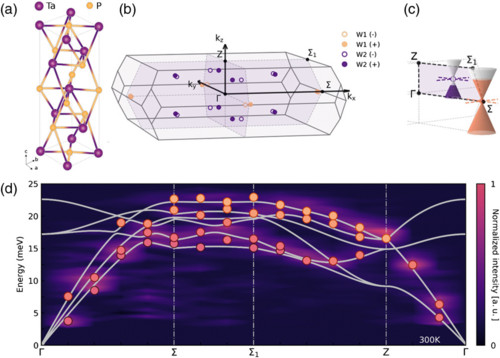Exotic states called Kohn anomalies been found for the first time in an unexpected type of material and this could lead to new quantum devices.
The researchers induced a Kohn anomaly, which was previously thought to exist only in metals, in an exotic material called a topological Weyl semimetal. The finding could help shed light on important aspects of the complex interplay between electrons and phonons.
Kohn anomalies, first discovered in the 1950s by physicist Walter Kohn, reflect a sudden change, sometimes described as a kind of kink or wiggle, in the graph describing a physical parameter called the electron response function. This discontinuity in an otherwise smooth curve reflects a sudden change of the capability of electrons for shielding phonons. This can give rise to instabilities in the propagation of electrons through the material, and can lead to many new electronic properties.
These anomalies have been observed before in certain metals and in other highly electrically conductive materials such as graphene, but had never been seen or predicted before in a “topological material,” whose electrical behaviors are robust against perturbation. In this case, a kind of topological material called a Weyl semimetal, specifically tantalum phosphide, was found to be capable of exhibiting this unusual anomaly. Unlike in conventional metals, where a property called the Fermi surface drives the formation of the Kohn anomaly, in this material, the Weyl points serve as the driving force.
Physical Review Letters – Topological Singularity Induced Chiral Kohn Anomaly in a Weyl Semimetal
Abstract
The electron-phonon interaction (EPI) is instrumental in a wide variety of phenomena in solid-state physics, such as electrical resistivity in metals, carrier mobility, optical transition, and polaron effects in semiconductors, lifetime of hot carriers, transition temperature in BCS superconductors, and even spin relaxation in diamond nitrogen-vacancy centers for quantum information processing. However, due to the weak EPI strength, most phenomena have focused on electronic properties rather than on phonon properties. One prominent exception is the Kohn anomaly, where phonon softening can emerge when the phonon wave vector nests the Fermi surface of metals. Here we report a new class of Kohn anomaly in a topological Weyl semimetal (WSM), predicted by field-theoretical calculations, and experimentally observed through inelastic x-ray and neutron scattering on WSM tantalum phosphide. Compared to the conventional Kohn anomaly, the Fermi surface in a WSM exhibits multiple topological singularities of Weyl nodes, leading to a distinct nesting condition with chiral selection, a power-law divergence, and non-negligible dynamical effects. Our work brings the concept of the Kohn anomaly into WSMs and sheds light on elucidating the EPI mechanism in emergent topological materials.

Brian Wang is a Futurist Thought Leader and a popular Science blogger with 1 million readers per month. His blog Nextbigfuture.com is ranked #1 Science News Blog. It covers many disruptive technology and trends including Space, Robotics, Artificial Intelligence, Medicine, Anti-aging Biotechnology, and Nanotechnology.
Known for identifying cutting edge technologies, he is currently a Co-Founder of a startup and fundraiser for high potential early-stage companies. He is the Head of Research for Allocations for deep technology investments and an Angel Investor at Space Angels.
A frequent speaker at corporations, he has been a TEDx speaker, a Singularity University speaker and guest at numerous interviews for radio and podcasts. He is open to public speaking and advising engagements.

